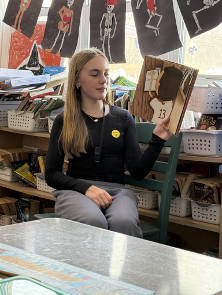By Erica Marcus, Mindfulness Director at Cape Elizabeth Middle School

Entering my fifth year as a Mindfulness Director at Cape Elizabeth Middle School, my students have taught me everything about how NOT to teach mindfulness. Too much seriousness, silence, and abstract philosophy have not landed well. More fun, activities, games, and challenges (even “stillness” ones) have provided an access point for more students to see the ways they could actually enjoy practicing mindfulness.
From there, it has felt like a natural stepping stone to have students actually teach mindfulness. However, it has required me to unravel the idea that one must be steeped deeply in their mindfulness practice to teach it to others. The inspiration for the Cape Elizabeth Middle School Mindfulness Ambassadors came from another WholeSchool Mindfulness Director, Jordan Grinstein. While I was operating from the perspective that one must be an expert in this field to teach, Jordan was working from the lens that students already have what they need, and with a little support, they can actually be gifted teachers. Watching him work with students- whether having them co-lead practices the first time he entered a room, or coordinate district-wide Zoom calls with minimal prep – made me realize that when properly supported, students know what they’re doing. They just need the space and time to do it. I have followed his lead, and the results have been powerful.
Being a Student Mindfulness Ambassador at Cape Elizabeth Middle School has varied from year to year depending on the schedule, time available, and the student interests. Over the years, students have created guided audio recordings from a mindfulness website and put up bulletin boards encouraging others to “Embrace Your Weirdness.” They have offered short practices over the announcements and co-wrote a grant to build out a mindful corner space in the library.
Most significantly, students from the middle school have been walking across campus to our elementary school to deliver 15-minute mindfulness lessons to the PreK through fourth grade students. When I went to talk to a group of fourth graders about the current seventh grade Mindfulness Ambassadors, I asked them how many people liked the program and thought it should keep going. Every hand shot up. When I asked why they thought the Mindfulness Ambassadors were good at their job, one said, “they are good because they know what we actually LIKE to do.”
What I find most inspiring is how these student mindfulness ambassadors naturally center fun in their mindfulness lessons—an approach I’m continually unlearning and relearning. Fun is not an afterthought. It’s the foundation. Students know what their peers and younger students actually enjoy, and that connection makes their lessons more engaging. Engagement gives them an access point.
Another benefit noted from both the elementary school teachers and mindfulness ambassadors themselves is building connections across the schools. The Mindfulness Ambassadors delight in going to see their old teachers, siblings, and neighbors. One seventh grader lit up as she talked about how the class didn’t really respond to them when they first started going, but now they all know their names and are excited to see them each week. Another said he ran into some of his former students at a baseball game and the preK students were SO excited to see him. I have seen the way these middle school students figure out how to command a group of excited and squirrely younger students, and the pride that comes from figuring that out.
Here are a few of my favorite Mindfulness Ambassador quotes:
“Being a mindfulness ambassador means that I can help others feel more themselves.” – Abby, 6th grade
“It makes me feel like I can do something in the school, and that I can help people.” – Kayleigh, 6th grade
This program has ripple effects far beyond mindfulness instruction.
So how does one build a mindfulness ambassadors program? So much depends on scheduling, physical building structures, and the interests of your students. Programs can run before or after school, during lunch or recess, or during study hall or elective blocks. Lessons can be delivered live or virtually, depending on if you have access to another building. We are still tinkering with those specifics at our school each year.
Once the structural pieces are determined, we turn the question on how we support students in delivering and creating their own lessons. My current mindfulness ambassadors had some thoughts about how adults can support students in teaching mindfulness. Here are five takeaways we came up with:
- Resources like mindful card decks, books, videos, and props help inspire students. We often start a Mindfulness Ambassador block by pulling cards and teaching them to one another to see how they work.
- Adults need to step back. Show students the resources and templates, then get out of the way. Let them lead the class and don’t interrupt (unless the class is really getting out of hand).
- Some students will need more support than others. Having regular check-ins to see how it’s going keeps them from going off the rails.
- Students like to teach in small groups (2-4 students seemed to work well. 6 did not.)
- It helps to have some foundation in mindfulness.
Recently, I’ve been talking with my 7th and 8th grade mindfulness ambassadors about inviting in 5th and 6th graders in for them to mentor. They were excited about the idea of taking these slightly younger students under their wing and teaching them what they’ve learned through their process. I can’t wait to see the next evolution of this program.
I hope you find ways of bringing this to life in your own classrooms.
As I’ve learned: Listen to them. Support them. Then get out of the way.